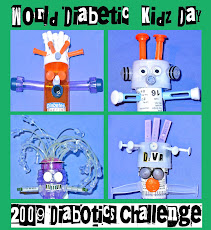This supplementary material discusses ways of joining pieces together to make diabotics. Getting small plastic pieces of different dimensions, some with curved surfaces, was less straightforward than we anticipated. We started with glue, but have now tried several methods, in response to numerous "complications" encountered - near-immediate "body-part shedding" of evolving creatures, diabotics who routinely wanted to tip over and those assembled creatures who failed our rigorous "durability assurance testing" process (which required a 5 minute survival of attack by 3 cats when dangled at the end of a plastic fishing pole).
We preface the following section, for those reading on, with the disclaimer that our diabotic projects have involved a rather detailed and extensive analysis of crafting materials. This approach to diabotics is neither necessary nor advocated and should probably be discouraged (reflecting simply a unique ability to transform small projects into Nobel scale operations). We don't want to detract from a commitment to keeping diabotics a simple endeavor.
In Supplementary Material I, we will discuss our experiences with glues, adhesive tape and polymer clay. We made lots of mistakes and incurred a few disasters along the way (so you don't have to). In Supplementary Material II, we will pay homage to the rotary tool and discuss other ways of holding parts together that require no added materials.
In Supplementary Material I, we will discuss our experiences with glues, adhesive tape and polymer clay. We made lots of mistakes and incurred a few disasters along the way (so you don't have to). In Supplementary Material II, we will pay homage to the rotary tool and discuss other ways of holding parts together that require no added materials.
Glue and Glue Alternatives
Getting small plastic pieces with curved surfaces to stick together was less straightforward than anticipated. We started by trying a handful of different types of glues, with some working significantly better than others. Our general findings so far: (1) clear glues work better than white ones. and (2) thicker (goopier) glues better than thinner (runnier) forms. At this point in our testing process, we are using a product called Crafter's Pick-The Ultimate Glue (a non-toxic, water-based general purpose adhesive generally safe for kids) and E6000 Crafter's Adhesive (which, given its chemical composition, should not be used by young children). Our favorite source for these is Articus Studio, a wonderful site for altered art supplies of all kinds (many excellent for diabotology), at reasonable prices, with comprehensive reviews of materials like glues (current prices: Crafter's Pick-The Ultimate Glue, 8 oz. $5.99, E6000 20z tube, $5.69).
Even with an effective glue, the optimal strategy involves letting one part dry for a few hours before adding another, a time factor that may frustrate kids (big or little). Double-sided tape and polymer clay were two items that emerged from our exploration into glue alternatives that proved particularly helpful.
Double-Sided Adhesive Tape
Double-Sided Adhesive Tape
Durable and very sticky double sided adhesive tape has been a useful diabotics investment for us. In the sea of current craft adhesives, some appear "less ideal" for diabotics (translated from polite lingo to mean that pieces fall off almost immediately). Avoid products labeled "repositionable". Our personal recommendation, based on ten years of using it for every possible purpose, Provo Terrifically Tacky Tape. It comes in 4 widths (particularly useful are 1/4 and 1/8 in) and can be widely purchased. We buy it from Articus Studio, where 5 yards of 1/8 in currently costs $2.25 and 5 yards of 1/4 runs for $2.99.
Polymer Clay
This is vastly under-rated as a medium and overall lifehacker tool. We have found it to be a worthy diabotic material, excellent for sticking oddly-shaped bits on evolving heads, proving to have fabulous "hair-base" potential, and providing a mechanism to stabilize wobbly legs and aerodynamically balance bodies that tended to tip over.
A basic working knowledge of polymer clay forms comes in handy, given its diverse applications. While trying to avoid excessive detail about the nature of polymers here, this polymer clay mini-review is necessary to understand safety issues: Polymer clay can be bake-able (many formulations, many brands) or dry upon exposure to air (air dry). The bake-able polymer clay forms, such as Sculpey and Fimo, widely and successfully employed and offering a broad range of properties uniformly share one limitation. They are associated with a risk of exposing children to pthalate (not a good thing), a component of the PVC from which they are made, if handled material is ingested or fumes are inhaled during baking at excessive temperatures. The two recently released air dry polymer clays, Makin's Clay® and Lumina®, represent a heralded innovation, as they are water-based and non-toxic (and, yes, more expensive and harder to find with Joann's offered as one personal source, with a frequently available 40% off coupon online that can be applied to one regularly-priced item).
Our polymer clay recommendations: (1) use whatever form you have available with older kids, (2) stick to baking temp guidelines and definitely use a separate craft oven (buy a toaster oven on Craigslist) and (3) work with air dry bakeable forms when doing projects with young children or when trying to hold together pieces that would melt in the toaster oven Most essential is that everyone thoroughly wash hands after diaboting.
These three diabotics (Russell, Lacosita and Piggy) demonstrate the ways that polymer clay can be used. Russsell's legs and arms are held in place with it, Lacosita sports a fabulous "Fimo"-do, and, if were not for polymer clay stuffed in his belly to weigh him down, Piggy would regularly topple over.






No comments:
Post a Comment